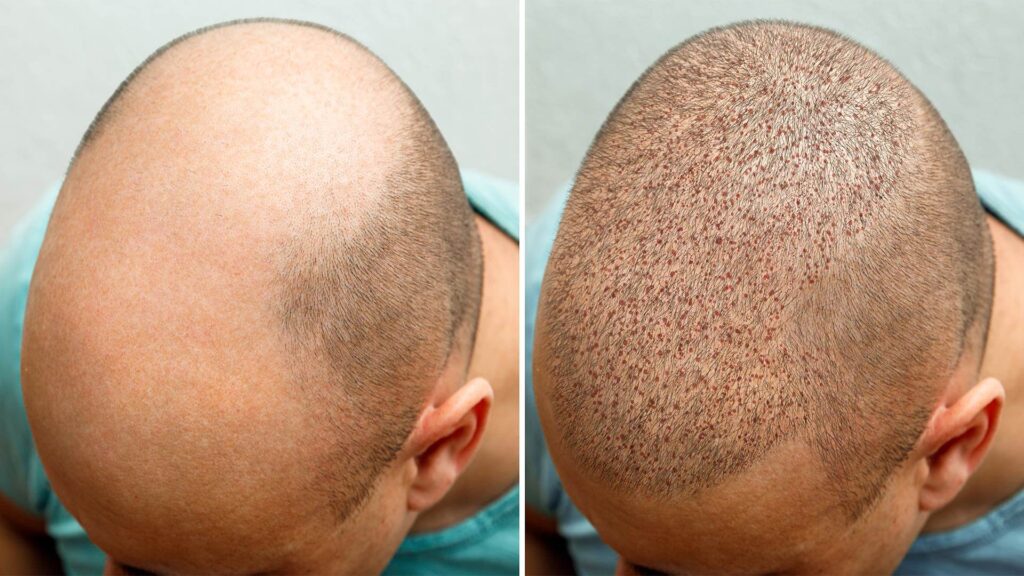Hair Transplant in Nashik
Hair Transplant
Hair transplant is a surgical procedure that involves the removal of hair from one part of the body, usually the back or sides of the head, and transplanting them onto the balding or thinning areas of the scalp. The procedure is primarily used to treat male pattern baldness, but it can also be used to restore hair on the eyebrows, beard, and chest. Hair transplant surgery is a cosmetic procedure that involves moving hair follicles from a donor area (usually the back or sides of the scalp) to the recipient area where hair is thinning or balding. The procedure can be performed using two primary methods: Follicular Unit Transplantation (FUT) and Follicular Unit Extraction (FUE).
Are you also suffering from severe hair issues and wish to have hair transplant then, visit CNS Hospital for Hair transplant treatment in Nashik.

There are two primary methods of hair transplantation:
Follicular Unit Transplantation (FUT):
This method of hair transplant involves removing a strip of skin from the donor area (usually the back of the head) where hair is abundant and resistant to balding. The strip is then dissected into small follicular units containing one to four hair follicles each. The surgeon then creates tiny incisions in the recipient area and carefully places the follicular units in these incisions. The incisions heal with minimal scarring and the transplanted hair grows naturally over time.
Follicular Unit Extraction (FUE):
This method involves removing individual hair follicles from the donor area one by one using a special punch tool. These follicles are then transplanted into the recipient area using tiny incisions. This method leaves minimal scarring and allows for a quicker recovery time than FUT.
In both methods, the transplanted hair follicles are taken from the back of the head as the hair in this area is genetically resistant to balding. The surgeon must carefully select the follicles to be transplanted based on their density, thickness, and growth rate.
The success of the hair transplant depends on several factors, including the skill and experience of the surgeon, the density and quality of the donor hair, and the patient’s age and overall health. It is important to choose a qualified and experienced surgeon and discuss the potential risks and benefits of the procedure before undergoing any hair transplant surgery.
Reasons you need hair transplant
Hair transplant surgery is typically recommended for individuals who are experiencing hair loss or balding due to a variety of reasons, including:
Male pattern baldness: This is the most common cause of hair loss in men, and is typically caused by genetics and hormones. Men with male pattern baldness may experience a receding hairline or thinning hair on the top of the head.
Female pattern baldness: Women can also experience hair loss or thinning, which may be caused by hormonal changes, genetics, or other factors.
Scarring alopecia: This is a type of hair loss that is caused by scarring on the scalp, which can be due to a variety of reasons, including injury, burns, or infection.
Trauma-related hair loss: Hair loss can occur as a result of physical trauma to the scalp, such as from a car accident or head injury.
Medical treatments: Certain medical treatments, such as chemotherapy, can cause hair loss.
Alopecia areata: This is an autoimmune condition that can cause hair loss in patches on the scalp.
If you are experiencing hair loss or balding and are considering hair transplant surgery, it is important to speak with a qualified and experienced surgeon who can evaluate your individual situation and recommend the best course of treatment for you.
Procedure of hair transplant
The hair transplant procedure typically involves the following steps:
Consultation: During the initial consultation, the surgeon will evaluate your hair loss and discuss your goals for the procedure. They will also review your medical history and medications you are currently taking to determine if you are a good candidate for hair transplant surgery.
Preparation: On the day of the surgery, the surgeon will shave the donor area and administer local anesthesia to numb the area.
Harvesting of hair follicles: For FUT, the surgeon will remove a strip of skin from the donor area, which will be dissected into individual follicular units containing one to four hair follicles each. For FUE, the surgeon will use a special punch tool to extract individual hair follicles from the donor area.
Creation of recipient sites: The surgeon will create tiny incisions in the recipient area where the hair will be transplanted.
Placement of hair follicles: The surgeon will carefully place the harvested hair follicles into the recipient sites, taking care to ensure proper placement and density.
Post-operative care: After the procedure, the patient will be given post-operative instructions, which may include taking pain medication and antibiotics, avoiding strenuous activities, and avoiding exposure to the sun.
Recovery: The recovery time can vary depending on the size of the procedure, but most patients can resume their normal activities within a week or two. The transplanted hair will begin to grow within a few months, and the full results of the procedure will be visible within 6 to 12 months.
It is important to note that hair transplant surgery is a cosmetic procedure and requires careful consideration and research before deciding to undergo the procedure. It is also important to choose a qualified and experienced surgeon to perform the surgery to ensure the best possible outcome.
After the procedure, the patient will be given post-operative instructions, which may include taking pain medication and antibiotics, avoiding strenuous activities, and avoiding exposure to the sun. The transplanted hair will fall out within a few weeks of the surgery, but new hair growth should be visible within a few months. The full results of the procedure will be visible within 6 to 12 months.
It is important to choose a qualified and experienced surgeon to perform the hair transplant procedure to ensure the best possible outcome. The surgeon will evaluate the patient’s hair loss pattern and the quality of their hair follicles to determine the best method for the hair transplant. They will also discuss the risks and benefits of the procedure and help the patient set realistic expectations for the outcome.
Best place for hair transplant in Nashik. Contact us today for consultation.

